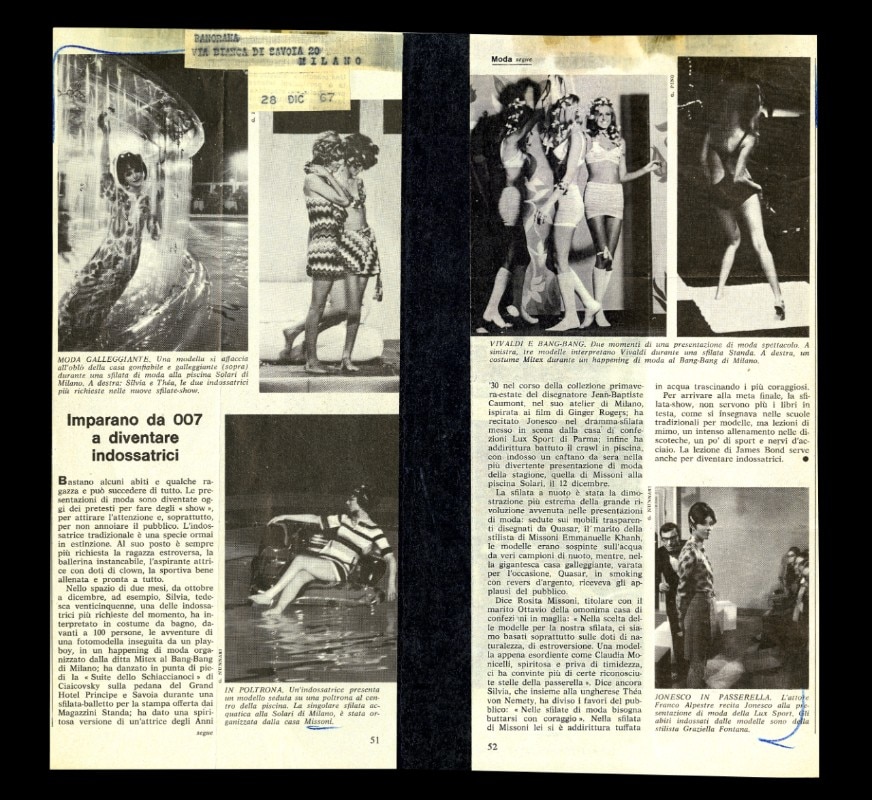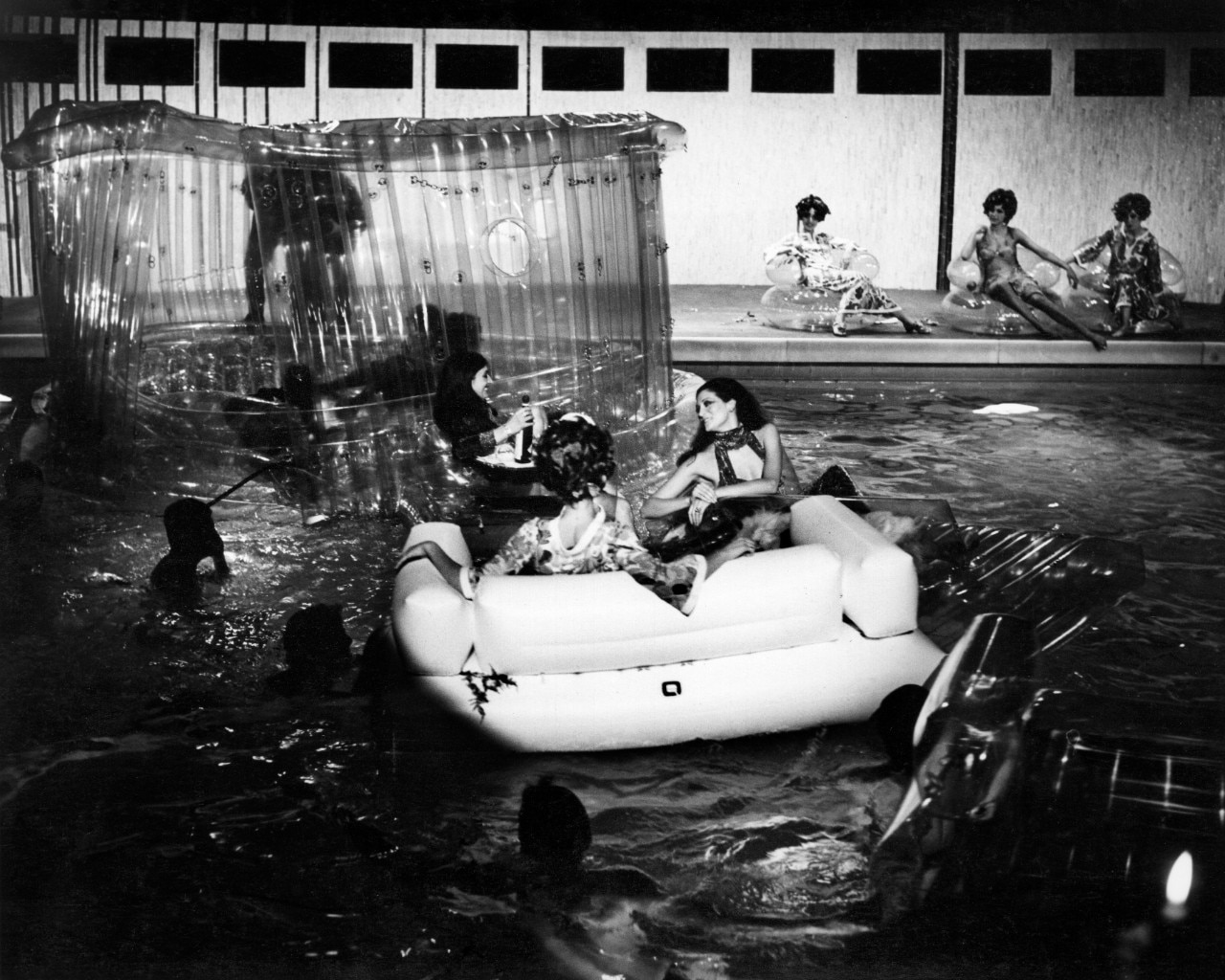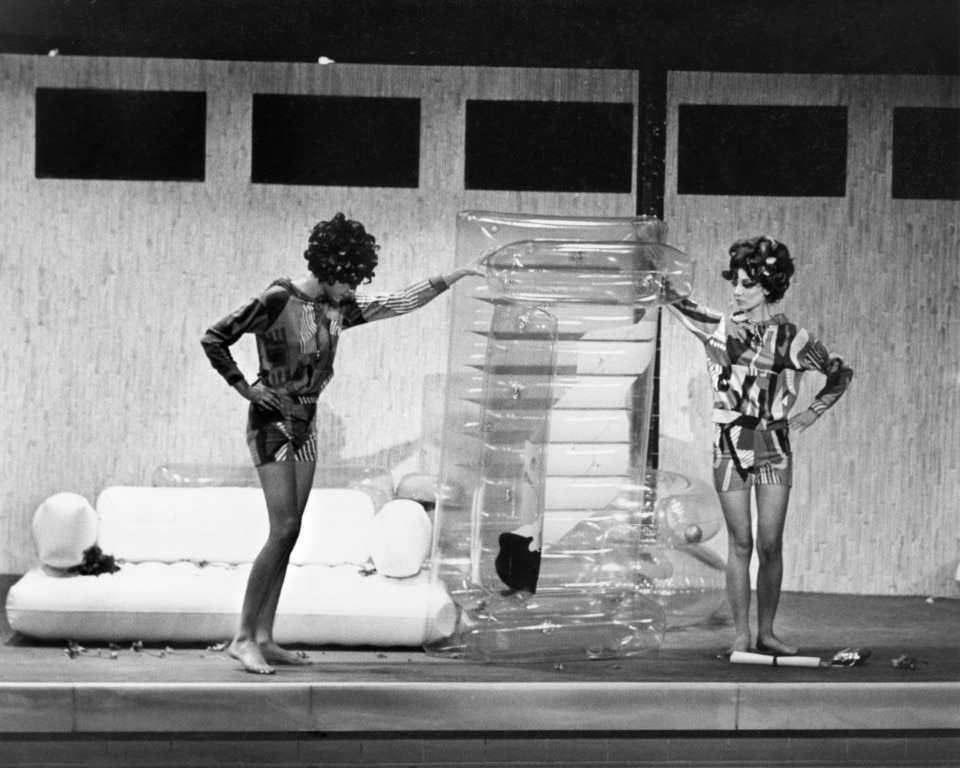On December 12, 1967, the Missoni fashion house debuted in Milan by presenting its collection at the Solari swimming pool. It did so by organizing an aquatic fashion show that has become legendary, involving Vietnamese designer Quasar Khanh.
In a time not too far away, fashion shows were real “happenings” designed as performance events. It was not simply a case of showing a new collection, it was more about aspiring to bring a certain cultural quality and content to the stage. The models turned into performers who danced, acted, and measured themselves against the surrounding space.
Precisely when art abandoned the dimension of the painting and the four walls of galleries to invade space and put the human body as its focus, a process of evolution and cultural revolution began in fashion, resulting in the organization of fashion shows that later made history.

The Solari swimming pool in Milan – where Missoni debuted in the world of fashion shows – was not just any old place, but a sports facility designed in 1963 by the brilliant Arrigo Arrighetti in the middle of the park of the same name. The architectural envelope is among the most interesting structures in the Milanese area, partly due to its sculptural forms and saddle-shaped roof, a defining element of the design.
This roof consists of two assemblies of steel ropes holding shaped metal elements, fine-tuned for this building. The ropes are then fixed to a reinforced concrete load-bearing structure, consisting of two large inclined arches that discharge their weights on two side blocks to avoid intermediate obstructions on the light of the complex.
In the Solari swimming pool areas, the presentation of Missoni’s fashion collection becomes the perfect chance to stage a fashion show on water, the result of a collaboration among Rosita Missoni, fashion designer Emmanuelle Khanh and her designer husband Quasar Khanh.

It all stems from the meeting between Rosita and Emmanuelle, a Parisian model for Balenciaga and Givenchy. The latter later became a fashion designer for a brand that bore her name and designer for major fashion houses such as Cacharel and, indeed, Missoni. In 1957, Emmanuelle had married Nguyen Manh Khanh, a Vietnamese engineer who had studied in Paris and became known as Quasar Khanh for his inflatable creations.
In May 1965, Rosita and Emmanuelle met for the first time in New York City by chance. “We were in the same hotel, the Plaza,” Rosita Missoni tells Domus. “She was already popular; I, on the other hand, felt like a novice. She stood out simply by her bearing and the way she dressed, and likewise her husband Quasar Khanh. I had already noticed them in the corridors.” Rosita Missoni recalls they had a drink together, “because she had to ask me for a favor to be her go-between to deliver an envelope to a person we both knew.” Then a new meeting, again in Paris. “We used to go to the Hotel Lutetia. And it was on that occasion that the idea of starting a collaboration between her and Missoni first came up.”
1967 was a special year for the Missoni family, who in April attended the Palazzo Pitti fashion shows in Florence for the first time. As Rosita says, an incident in progress occurred that day. An incident that later becomes an important opportunity to put the Missoni family in the spotlight. “We were dressing the models to send them out on the catwalk when I noticed that under our very thin black lamé knit dresses the models’ underwear was showing through. A totally unaesthetic effect. I decided to send them on the catwalk without a bra, so with the spotlights on the catwalk at the Palazzo Pitti their nudity was shining through, which would be okay today, while at the time it was a scandal.”

Therefore, Rosita and her brother Ottavio are not invited to Florence for the following edition. The two seize the opportunity to present their spring-summer collection in Milan, at the Solari swimming pool, deciding to involve Emmanuelle’s husband, Quasar Khanh, in creating an aquatic fashion show on inflatable chairs and floating, transparent furniture.
Quasar is an extraordinary personality, as reflected even in his choice to take the name of one of the most mysterious and fascinating celestial objects known. Graduated in Engineering from the École Nationale des Ponts et Chaussées in Paris in 1959, Khanh took up the study and design of inflatable design by chance, working on the construction of the world’s largest multiple arch dam for the consulting and engineering firm Coyne et Bellier.
The problem of the toxicity of mercury and lead used for construction had had to be addressed in the realization of the Manicouagan 5 dam in Canada. Khanh – while looking for an alternative to these materials and the pressure they exerted – considered using compressed air as a design material. From this insight came Khanh’s 1967 collections of inflatable furniture, installed at the Solari swimming pool for the Missoni fashion show.

“We were supposed to present our summer collection, and at the same time Quasar had his inflatable designer sculptures to present but he did not know how to do so. Learning about our fashion show in the swimming pool he asked us to participate. It resulted in a memorable fashion show that ended with all the models in the water.” Indeed, because the fashion show was a real performance, the most extreme demonstration of the great revolution that took place in fashion presentations in those years.
A fashion show that now becomes an image of a time gone by, of those 1960s in which a whole new series of new experiments in architecture, design and art on the “inflatable” theme were born in Europe and America. An image of a time when artists, planners and designers, still weighed down by the postwar period, pushed their research to extremes, proceeding toward new forms of inhabiting and occupying space.

Outdoors: at the Milano Design Week, a new product by Nardi
With a patented system and durable, sustainable materials, Plano is Nardi's signature lounger designed by Raffaello Galiotto.













